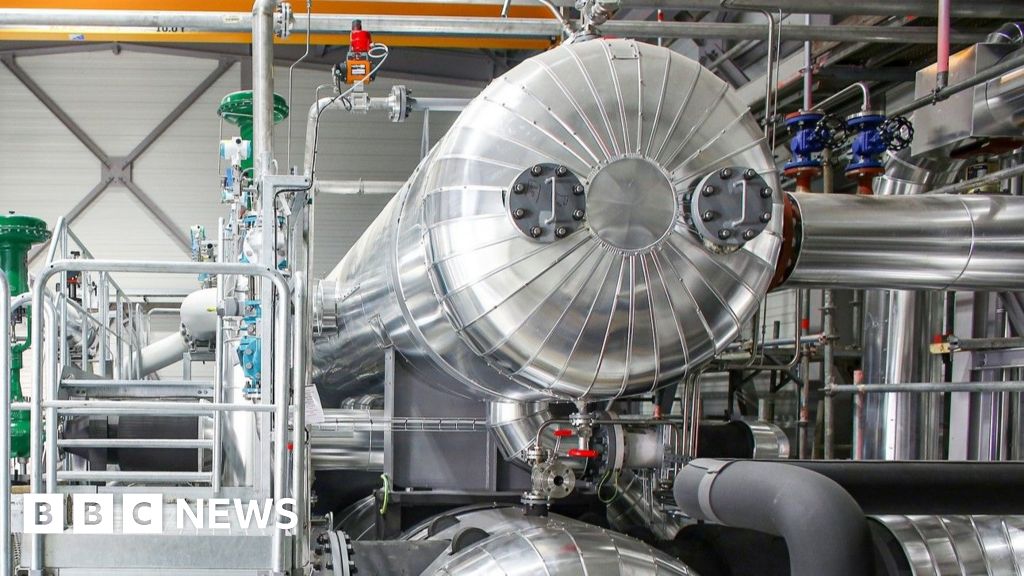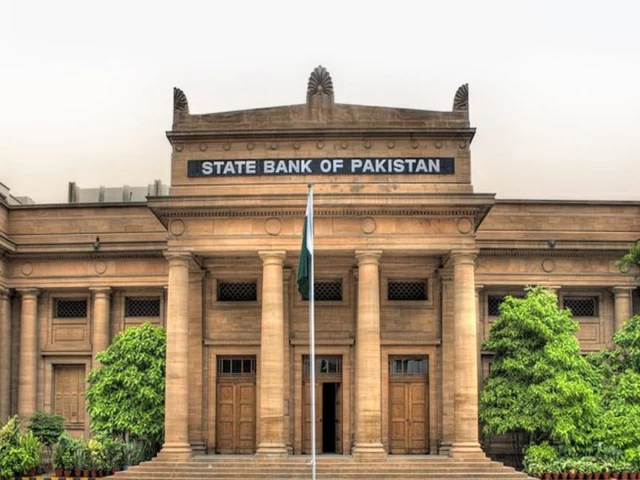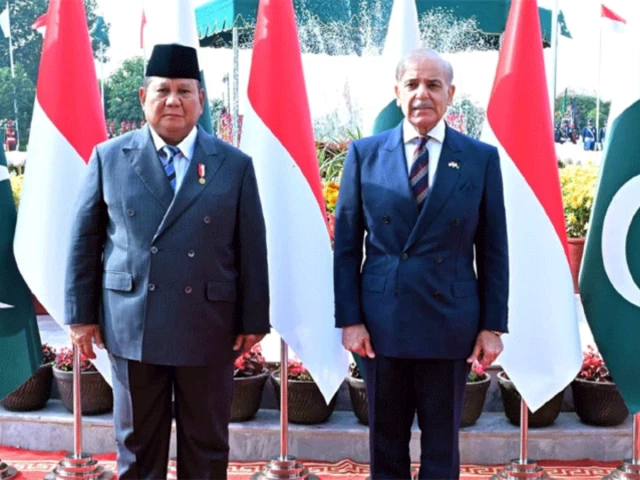Business
Other side of multinationals’ exit story | The Express Tribune

As some long-entrenched firms leave, new players move in, drawn by signs of economic recovery and growth
Also likely to levy income tax on companies suffering gross losses. PHOTO: NASDAQ
ISLAMABAD:
“All happy families are alike; every unhappy family is unhappy in its own way.” Leo Tolstoy
Procter & Gamble’s exit from Pakistan has reignited debate over the country’s business climate. Many view it as part of a broader trend of multinational companies leaving amid mounting economic challenges. Analysts have pointed to high corporate taxes, restrictions on profit repatriation, and a cumbersome regulatory environment as key reasons. But the story is more complex.
Over the past four years, nine multinational companies have exited or divested their operations in Pakistan. Four of these were manufacturers – three pharmaceutical firms (Pfizer, Sanofi-Aventis, and Eli Lilly) and one consumer goods company (P&G). The remaining were service-sector players such as Shell, Total, Telenor, and Uber/Careem. The pharmaceutical sector has seen the most exodus; though this is not new. Three decades ago, 48 multinational drug companies operated in Pakistan. Today, fewer than half remain. Most have gradually divested, transferring operations or product registrations to local firms that now command over two-thirds of the domestic market.
Price controls and rigid regulations have made it harder for global firms to operate profitably, while local players have grown stronger, more agile, and more competitive.
P&G’s decision appears to reflect its global priorities more than Pakistan’s domestic conditions. Its strategy now centres on manufacturing in major markets like the United States, Europe, Greater China, and India, while exiting relatively smaller markets including Nigeria, Argentina, Bangladesh, Kenya, and others in Latin America.
In the services sector, exits also reflect broader global restructuring rather than a loss of investor confidence. Shell’s sale of its Pakistan operations to Saudi-based Wafi Energy aligns with its strategy to exit retail fuel businesses in several countries. Telenor’s decision, taken in 2022, is part of a move to focus on a smaller set of core markets. Uber and Careem have yielded market share to more affordable competitors such as InDrive and Yango. As some long-entrenched firms leave, new players are moving in, drawn by signs of economic recovery and growth. China’s Challenge Group is investing $150 million in Punjab to develop a high-tech textile zone expected to generate 18,000 jobs and an estimated $100 million in apparel exports.
Consumer healthcare multinational company Haleon is expanding its Jamshoro facility, positioning Pakistan as a regional manufacturing hub and targeting a sizeable part of production for export. Belarus plans to set up a tractor manufacturing joint venture in Balochistan.
In the financial sector, the sale of First Women Bank Limited marks the first successful privatisation in two decades. Though a small transaction, the acquisition by a multibillion UAE investment holding company signals growing investor interest as it explores more opportunities in Pakistan. UAE’s Mashreq Bank is also investing $100 million, aiming to expand financial access for the unbanked and establish Pakistan as a back-office hub for its global operations.
The largest new wave of investment is expected from China as both countries resume work on the long-delayed second phase of CPEC. New investments amounting to $8.5 billion, including $1.5 billion in joint ventures, have recently been finalised, targeting key sectors such as agriculture, renewable energy, electric vehicles, healthcare, steel, and other emerging industries.
It is essential that these new investments do not repeat the old import-substitution model pursued by many existing companies. Instead, they should emulate the example of the Chinese-Pakistani joint venture, Service Long March (SLM) Tyres, which has successfully captured most of the domestic market once dominated by smuggled goods and is now exporting tyres worth $100 million annually, mostly to the United States.
The real challenge for policymakers is to identify and replicate such success stories. Pakistan hosts over 200 multinational companies that play a vital role in driving commerce and industry and contribute more than one-third of the FBR’s total tax collection. Yet, despite this significant presence, their export footprint remains negligible, even as they repatriate over $1.5 billion in profits annually.
In contrast, multinationals operating in other developing countries are far more outward-looking, focused on global markets, earning substantial foreign exchange, and contributing to export growth rather than relying primarily on domestic sales.
The recent reforms to Pakistan’s trade and tariff policies offer an opportunity to shift towards export-led growth, and multinationals can and should play a central role in that transition, as they have elsewhere.
The era of special concessions through SROs and high tariff protection is drawing to a close. Companies can no longer afford to depend on importing components at low duties, assembling them, and selling locally at high margins in a highly protected market.
To remain relevant and competitive, they must break this cycle of dependency and embrace an export-oriented strategy, one that rewards efficiency, innovation, and global competitiveness. This is precisely how the East Asian economies transformed their industrial landscapes and achieved lasting prosperity. By following similar policies, Pakistan can do the same.
The writer is a member of the steering committee overseeing the implementation of the National Tariff Policy 2025-30. He has previously served as Pakistan’s ambassador to the WTO and FAO’s representative to the United Nations
Business
Ben & Jerry’s: Row deepens as three board members removed

Three members of Ben & Jerry’s independent board will no longer be eligible to serve in their roles, after the ice cream company introduced a new set of governance practices.
These include a nine-year limit set on board members’ terms. Chair Anuradha Mittal, who earlier said she had no plans to resign under pressure, is among those affected.
The move was criticised by the company’s co-founder Ben Cohen, who called it a “blatant power grab designed to strip the board of legal authority and independence”.
His remarks are the latest in a long-running row between Ben and Jerry’s and its owner over the Cherry Garcia maker’s social activism and the continued independence of its board.
The BBC understands that Ms Mittal will leave the company immediately, while board members Mr Dodson and Ms Henderson will go at the end of this year.
“Anuradha Mittal, Daryn Dodson, and Jennifer Henderson have served this company with integrity and courage. Over many years, they helped the board make bold, often difficult decisions to uphold Ben & Jerry’s social mission,” said Mr Cohen.
Ben & Jerry’s said the move is aimed “to preserve and enhance the brand’s historical social mission and safeguard its essential integrity.”
The Vermont-based firm is now owned by The Magnum Ice Cream Company, after a spinoff from Unilever last week that created the world’s largest standalone ice cream maker.
A spokesperson for Magnum said the firm wanted to build and strengthen Ben & Jerry’s “powerful, non-partisan values-based position in the world”.
But Ben & Jerry’s would be destroyed as a brand if it remains with Magnum, Mr Cohen told the BBC.
Ben & Jerry’s was sold to Unilever in 2000 in a deal which allowed it to retain an independent board and the right to make decisions about its social mission.
Since the sale there have been deepening clashes between the Vermont-based brand and Unilever, with this conflict now inherited by Magnum.
In 2021, Ben & Jerry’s refused to sell its products in areas occupied by Israel, resulting in its Israeli operation being sold by Unilever to a local licensee.
Co-founder Jerry Greenfield left Ben & Jerry’s in September after almost half a century at the firm, deepening a dispute with parent company Unilever.
In a letter shared on social media by Mr Cohen, Mr Greenfield said Ben & Jerry’s had lost its independence after Unilever put a halt to its social activism.
Business
Amazon Layoffs: Tech Giant Cuts More Jobs In These Domains, Separate From 14,000 Global Firings

Last Updated:
Amazon cuts 84 jobs in Seattle and Bellevue, separate from 14000 global layoffs, citing routine business reviews. CEO Andy Jassy links future reductions to generative AI expansion.
Amazon to cut more jobs
The spree of layoffs doesn’t appear to be ebbing despite large-scale firings in tech giants. Amazon has reportedly cut 84 jobs, separate from 14000 corporate layoffs in October globally, according to a report of Greekwire.
Amazon said as reported by Greekwire that these job cuts aren’t linked to broader workforce actions. “Each of its businesses regularly reviews its organizational structure and may make adjustments as a result. Terming it a “routine process”.
“We’ve informed a relatively small number of employees that their roles will be eliminated as the result of individual business decisions,” said Amazon spokesperson Brad Glasser. “We don’t make decisions like this lightly,” he added, noting that the company is providing affected employees with 90 days of full pay and benefits, transitional health coverage, and job placement services.
As a new State law the State’s new version of the Worker Adjustment and Retraining Notification Act, known as the WARN Act. requires companies/employers to disclose all terminations within 90 days of a prior notice, Amazon intimated the Washington Authorities.
According to an Amazon filing, the separations are set to take place between February 2 and February 23, 2026, affecting staff across more than 30 office locations in Seattle and Bellevue, along with six remote employees based in Washington.
The roles impacted reportedly include software development engineers, program managers, recruiters, HR specialists and UX designers, spanning levels from entry-level positions to directors and principals.
Amazon said employees were informed beginning in early November and were given at least 89 days’ advance notice, well above the 60-day requirement under the law. The company added that employees who secure internal transfers before their separation date will not be laid off.
In June, CEO Andy Jassy, who has aggressively sought to cut costs since becoming CEO in 2021, said that he anticipated generative AI would reduce Amazon’s corporate workforce in the next few years.
Jassy said at the time that Amazon had more than 1,000 generative AI services and applications in progress or built, but that figure was a “small fraction” of what it plans to build. Jassy encouraged employees to get on board with the company’s AI plans after it announced plans to invest $10 billion building a campus in North Carolina to expand its cloud computing and artificial intelligence infrastructure.
December 16, 2025, 08:36 IST
Read More
Business
The giant heat pumps designed to warm whole districts

Chris BaraniukTechnology Reporter
 MVV Energie
MVV EnergieThe pipe that will supply the heat pump, drawing water from the River Rhine in Germany, is so big that you could walk through it, fully upright, I’m told.
“We plan to take 10,000 litres per second,” says Felix Hack, project manager at MVV Environment, an energy company, as he describes the 2m diameter pipes that will suck up river water in Mannheim, and then return it once heat from the water has been harvested.
In October, parent firm MVV Energie announced its plan to build what could be the most powerful heat pump modules ever. Two units, each with a capacity of 82.5 megawatts.
That’s enough to supply around 40,000 homes, in total, via a district heating system. MVV Energie aims to build the system on the site of a coal power plant that is converting to cleaner technologies.
The scale of the heat pumps was determined partly by limits on the size of machinery that could be transported through the streets of Mannheim, or potentially via barges along the Rhine. “We’re not sure about that yet,” says Mr Hack. “It might come via the river.”
One person well aware of the project is Alexandre de Rougemont, at Everllence (formerly MAN Energy Solutions), another German company that also makes extremely large heat pumps. “It is a competition, yeah,” he says. “We’re open about it.”
Heat pumps soak up heat from the air, ground or, in these cases, bodies of water. Refrigerants inside the heat pumps evaporate when they are warmed even slightly.
By compressing the refrigerant, you boost that heat further. This same process occurs in heat pumps designed to supply single homes, it just happens on a much larger scale in giant heat pumps that serve entire city districts.
As towns and cities around the world seek to decarbonise, many are deciding to purchase large heat pumps, which can attach to district heating networks.
These networks allow hot water or steam to reach multiple buildings, all connected up with many kilometres of pipe. Ever bigger models of heat pump are emerging to meet demand.
“There was a lot of pressure on us to change the heat generation to new sources, especially renewable sources,” explains Mr Hack as he discusses the decommissioning of coal-fired units at the Mannheim plant. The site is right by the Rhine, already has a hefty electricity grid connection, and is plugged in to the district heating network, so it makes sense to install the heat pumps here, he says.
He notes that the technology is possible partly thanks to the availability of very large compressors in the oil and gas industry – where they are used to compress fossil fuels for storage or transportation, for example.
 MVV Energie
MVV EnergieWork on the Mannheim project is due to start next year. The heat pumps – with a combined capacity of 162MW – are set to become fully operational in the winter of 2028-29. Mr Hack adds that a multi-step filter system will prevent the heat pumps sucking up fish from the river, and that modelling suggests the system will affect the average temperature of the river by less than 0.1C.
Installations such as this are not cheap. The Mannheim heat pump setup will cost €200m ($2.3m; £176m). Mr de Rougemont at Everllence says that, at his company, heat-pump equipment costs roughly €500,000 per megawatt of installed capacity – this does not include the additional cost of buildings, associated infrastructure and so on.
 Everllence
EverllenceEverllence is currently working on a project in Aalborg, Denmark that will be even more powerful than the system in Mannheim, with a total capacity of 176MW. It will use smaller modules, however – four 44MW units – and is due to become operational in 2027, when it will supply nearly one third of all heating demand in the town.
Those 44MW machines are actually the same ones used in a previous project, now fully operational, to the south of Aalborg in Esbjerg. There, they don’t run at maximum capacity but rather supply 35MW each.
Large hot water storage tanks, each able to hold 200,000 cubic metres of liquid, will give the system added flexibility, adds Mr de Rougemont: “When the electricity price is high, you stop your heat pump and only provide heat from the storage.”
Veronika Wilk at the Austrian Institute of Technology says, “Heat pumps and district heating systems are a great fit.” Such systems can harvest heat from bodies of water or even wastewater from sewage treatment plants.
Dr Wilk notes that, when you use multiple large heat pumps on a district heating network, you gain flexibility and efficiency. You could run two out of four heat pumps in the autumn, say, when less heat is required than during the depths of winter.
 Getty Images
Getty ImagesAll the systems mentioned so far harvest energy from water sources but, less commonly, very large heat pumps can use the air as a heat source, too. Even in a relatively cold city such as Helsinki.
“The sea in front of Helsinki is too shallow,” explains Timo Aaltonen, senior vice president of heating and cooling at Helen Oy, an energy firm. “We calculated that we would need to build a tunnel more than 20km long to the ocean, to get enough water [with a] temperature high enough.”
Helsinki is in the process of radically overhauling its district heating system. The city has added heat pumps, biomass burners and electric boilers to a 1,400km network that links up nearly 90% of buildings in the Finnish capital, adds Mr Aaltonen.
Heat pumps convert single kilowatt hours of electricity into multiple kilowatt hours of heat but electric boilers can’t do this and are therefore considered less efficient.
I ask why Helen Oy decided to install hundreds of megawatts of these boilers and Mr Aaltonen says that they are cheaper to install than heat pumps and having them also means he and colleagues don’t have to rely entirely on the air, which is limited in terms of how much heat it can provide at scale. Plus, the electric boilers can help to soak up surplus renewables and provide an electricity grid-balancing function, he says.
There are no heat pumps in the UK that rival the systems under development in Denmark, Germany and Finland. However, some new district heating networks are on the way, such as the Exeter Energy Network, which will supply the University of Exeter and other customers.
The minimum planned capacity of the network is 12MW. It will feature three 4MW air-to-water heat pumps, with the first unit due to become operational in 2028.
Keith Baker at Glasgow Caledonian University, who researches district heating systems, says the UK has opportunities to make more of this technology. Water in disused mines, which maintains a relatively stable temperature, is beginning to supply larger heat pumps here, for example.
Post-industrial and rural areas where there is adequate space to install heat pumps and heat storage tanks are “the sweet spots”, he says.
-

 Politics1 week ago
Politics1 week agoThailand launches air strikes against Cambodian military: army
-

 Politics1 week ago
Politics1 week agoZelenskiy says Ukraine’s peace talks with US constructive but not easy
-

 Fashion1 week ago
Fashion1 week agoGermany’s LuxExperience appoints Francis Belin as new CEO of Mytheresa
-

 Politics5 days ago
Politics5 days agoTrump launches gold card programme for expedited visas with a $1m price tag
-

 Tech6 days ago
Tech6 days agoJennifer Lewis ScD ’91: “Can we make tissues that are made from you, for you?”
-

 Business6 days ago
Business6 days agoRivian turns to AI, autonomy to woo investors as EV sales stall
-

 Entertainment1 week ago
Entertainment1 week agoToo big to fail? IndiGo crisis exposes risks in Indian aviation
-

 Sports5 days ago
Sports5 days agoPolice detain Michigan head football coach Sherrone Moore after firing, salacious details emerge: report













